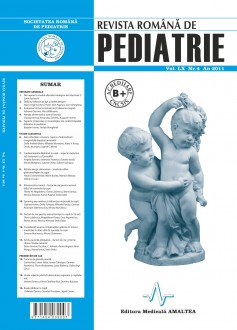SELECT ISSUE

Indexed

| |

|
|
|
| |
|
|
|

|
|
|
|
|
|
|
HIGHLIGHTS
National Awards “Science and Research”
NEW! RJP has announced the annually National Award for "Science and Research" for the best scientific articles published throughout the year in the official journal.
Read the Recommendations for the Conduct, Reporting, Editing, and Publication of Scholarly work in Medical Journals.
The published medical research literature is a global public good. Medical journal editors have a social responsibility to promote global health by publishing, whenever possible, research that furthers health worldwide.
Risk factors for asthma in children (6-18 years)
Oana Lăzărescu, Magdalena M. Florea, Ema Agarniciuc, Ileana Ioniuc, Monica Alexoae and Stela Gotia
ABSTRACT
Asthma is one of the most common diseases in children and an important cause of morbidity and mortality, with recent increased prevalence. Asthma diagnosis in children is often underestimated in early childhood. The aim of present study is to anamnestically assess using clinical and specific paraclinic exploration the incidence of the risk factors highly suggestive of asthma in children (6-18 years) and the correlation with disease severity. The questionnaires used in this study included relevant information to known risk factors for asthma during pre and postnatal period, preadolescence and adolescence stage. The principal risk factors for asthma identified in descending order of frequency were: personal atopy, recurrent wheezing, male gender, urban environment, indoor air allergens exposure (house dust, domestic animals, house mold) allergic sensitization to indoor allergens (house-dust mites), infant artificial feeding, family atopy, exposure to second hand tobacco smoke. Allergic polisensitization and tobacco smoke exposure are associated with severe asthma. The majority of cases were affected by asthma-related comorbid conditions and allergic rhinitis was the most frequent comorbidity.
Key words: asthma, child, risk factors, atopy
